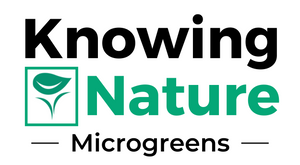Frequently Asked Questions
Click on the question below to find an instant answer.
Planter
The KnowingNature Planter is a reusable planter that is specially designed to grow microgreens indoors using soil or coco coir. What makes the KnowingNature Planter unique from other products on the market:
1. Its is made of BPA free & FDA certified food safe plastic 2. It is compatible for growing with coco coir and soil so that you can grow your way without being beholden to special matts or refills, and 3. It is super easy to use at home & in class.
1. Microgreens growers who want to grow on their windowsills.
2. Adults & kids who enjoy plants & gardening.
3. Growing in low light or in a small space.
4. Growing indoors during the cold season.
5. Growing to gain experience and knowledge about plants.
6. Educators who want to plant in class for nature subjects, STEM skills, center time or science experiments.
Clean it in the dishwasher or by hand with soapy water and it is ready to be planted again. KnowingNature Planters are compatible for growing all varieties of microgreens in soil or coco coir. Use with your own soil and seeds, or save time and space by ordering our soil + seed refills.
Microgreens🌱
Your garden only needs light after the seeds germinate. Until then, put your garden someplace 1. you walk by each day and 2. the temperature does not dip below 68 F (20 C). After germination, your garden will need light to be happy. Direct or indirect sunlight is fine as long as it is unobstructed by shades, curtains, etc., during the day. Windowsills are perfect. The beauty of microgreens is that they get most of their energy from the seeds and need relatively little sunlight to thrive before they are ready to harvest. Pro tip: Winter months have less hours of sunlight than spring and summer, so during those months it is more important to get the most out of the hours of sunlight you do have.
EverySeason Gardens usually need to be watered 3-5 times before being harvested (depending on the seed type).
How often depends on:
1. How hot the room is.
2. How big your plants are.
Seeds don't have roots and absorb very little water, so the biggest question is how hot the room is. The bigger your plants are, the more they drink and the more often you will need to water them.
As a rule of thumb: after Day 1 your soil will probably stay moist for 3 or 4 days because the plants have no roots to drink water. After Day 4, the garden may need to be watered every other day, and perhaps everyday on the last day or two. How will you know? Look at the soil color & lift the Insert: wet soil is a darker color & heavier than dry soil.
Also look at your plants: droopy plants are thirsty plants. To water, bottom water by filling The Tray with water and letting the Insert absorb just the right amount of water (like you did on Day 1).
Discard any water remaining after 5 minutes.
The plants will keep growing, but you will not be able to get another harvest out of them. After your cut them, we suggest you have fun exploring the root system then either compost or discard the soil.
We suggest pulling them out of the Insert and getting an up close and personal look. After you have fun exploring the root system, you can compost or discard the soil, and wash the planter so it is ready for its next use.
Most seeds have the same potential, including how tall they can grow, so differences in how they grow has to do with their environment. If one side of your garden is taller than the other, that means the taller side got a head start and germinated first. Why would one side germinate faster than the other? The most common reason is a difference in temperature. Perhaps the shorter side was touching a window that is very cold, or the taller side sits close to a heater. The less likely reason is uneven watering - if the garden was on an uneven surface and only the taller side received enough water, or the Tray needed more water to thoroughly soak all the seeds.
The care guides give a good idea of what to expect. If seeds are germinating slower than the care guide predicts, the most likely reason (especially during winter months) has to do with temperature.
Seeds need warm temperatures to germinate. Generally, room temperature works great, however if the garden is on a surface that gets particularly cold (like a windowsill that is letting in cold air, touching a window that is very cold, or sitting on a granite counter top), then the seeds may not have enough heat to germinate.
As a solution, try placing the garden in a particularly warm spot until after it germinates. Once all the seedlings are above the soil line, it should be safe to place them onto a windowsill, even chilly ones.
A less likely reason is that the seeds have not received enough water. Seeds need to absorb a certain amount of water to germinate. Perhaps more water needed to be poured into the Tray, or the water in the Tray was dumped too quickly, or the garden's environment is so hot that the soil dried quickly, or the soil was packed so tight into the Insert that it is not absorbing water properly.
Shipping 📦
🗽U.S. orders - shipping is free to all U.S. states & territories.
🍁NEW! As of August 2020, we deliver to Canada! We offer $10 flat rate shipping to all Canadian territories.
Orders are generally shipped on the following business day and arrive within 2-8 business days from the date of the order.

